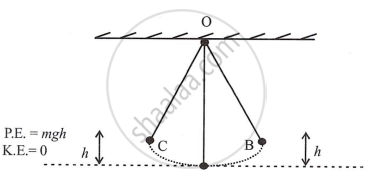Advertisements
Advertisements
प्रश्न
Name two examples in which the mechanical energy of a system remains constant.
उत्तर
(1) A body hurled vertically upward under gravity experiences a continuous increase in P.E. and a continuous decrease in KE. The sum of these two quantities at any one time stays constant.

(2) Because of the height h above ground and KE = 0, in the case of a simple pendulum at B, Bob just has P.E.
∴ Sum of P.E. + K.E. = mgh + 0 = mgh
At A the resting position h = 0 and P.E. = 0 but has maximum KE. (Since P.E. has been converted into KE.)
∴ Sum of P.E. and K.E. is same at A as at B.
Now again as bob rises above ground to position C, K.E., decreases to zero and P.E. = mgh
∴ Sum of P.E. and K.E. = mgh
We see that in all three places, P.E. + K.E., i.e., the mechanical energy of the system, remains constant.
APPEARS IN
संबंधित प्रश्न
A certain form of energy which is not sourced directly or indirectly from the sun and does not cause any pollution is very easily converted into electricity. This form of energy is, however, not available everywhere. Moreover, it is technically very difficult and expensive to obtain it. Name the form of energy.
Give one relevant example for the following transformations of energy:
Chemical energy to heat energy.
Select the renewable and non-renewable sources of energy from the following:
Wood
Why using wood as fuel is not advisable although wood is a renewable source of energy?
What is wind energy?
Explain the principle of producing electricity using the nuclear energy.
What is the main energy transformation that occur in:
Photosynthesis in green leaves.
State the energy changes which take place when:
Food is digested by animals.
State the energy changes which take place when:
Burning of coal.
Show that in case of a body falling freely under gravity, total mechanical energy remains conserved (neglect air resistance).
